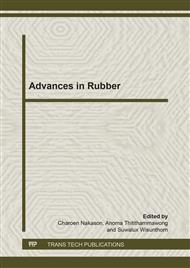p.458
p.462
p.466
p.470
p.474
p.478
p.482
p.486
p.490
Improved Deproteinization Process for Protein-Free Natural Rubber Latex
Abstract:
Hev b1-14 type proteins in natural rubber latex (NRL) have been identified as allergens in immunogenic responses. Several methods have been developed to reduce these proteins from NRL such as enzyme treatment, centrifugation, creaming, simple or ultrasonic leaching, and chlorination. In this work, the improvement of deproteinization of NRL was developed using the combination of enzyme treatment and leaching processes. The fresh NRL was incubated with 0.2 phr proteolytic alcalase enzyme, and preserved with 2%v/v paraben concentrate in the presence of a 2%v/v sodium lauryl ether sulfate (SLES) as a surfactant at 37°C for 24 hours, and then centrifuged. The upper rubber mass was then leached for three times with either distilled water, a 1%v/v SLES solution, or a mixture of 1%v/v SLES and 2.5%v/v ethanol, and then finally re-dispersed in distilled water. It was found that the increasing process of leaching with either 1%v/v SLES or a mixture of 1%v/v SLES and 2.5%v/v ethanol had the higher efficacy to reduce the remained protein in deproteinized NRL (DNRL). The best deproteinized process was the enzyme treatment and followed by the three times leaching process with a mixture of 1%v/v SLES and 2.5%v/v ethanol, that could completely reduce the proteins in DNRL to 0%. This DNRL had the pH value, viscosity, dry rubber content, and total solid content of 7.41, 13.82 cps, 42.57%, and 44.63%, respectively. Its particle size was 626.23 nm with low polydispersity index of 0.16. The negative charge of SLES could increase the higher negative charge of DNRL to-63.20 mV that exhibited very good physical stability during storage. In conclusions, the combination of enzyme treatment and leaching process with both SLES and ethanol was successful to produce the protein-free DNRL. This DNRL could be further used for several applications including medical skin products.
Info:
Periodical:
Pages:
474-477
Citation:
Online since:
November 2013
Price:
Сopyright:
© 2014 Trans Tech Publications Ltd. All Rights Reserved
Share:
Citation:


